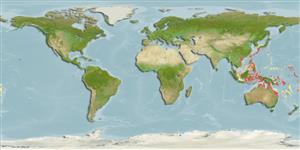>
Gobiiformes (Gobies) >
Gobiidae (Gobies) > Gobiinae
Etymology: Psilogobius: Greek, psilos = hairless + Latin, gobius = gudgeon (Ref. 45335).
More on authors: Watson & Lachner.
Environment: milieu / climate zone / depth range / distribution range
Ökologie
seewasser riff-verbunden; tiefenbereich 1 - 20 m (Ref. 90102). Tropical
Indo-Pacific.
Size / Gewicht / Alter
Maturity: Lm ? range ? - ? cm
Max length : 5.5 cm SL Männchen/unbestimmt; (Ref. 48637)
Rückenflossenstacheln (insgesamt) : 6 - 7; Rückenflossenweichstrahlen (insgesamt) : 10; Afterflossenstacheln: 1; Afterflossenweichstrahlen: 9 - 10. Characterized by pale grey to brownish body color with five large, ovate dark brown blotches on side of body; anterior part of body with narrow white bars; upper half of head and body with brown mottling and small blue spots; blue streaks aligned with fin rays on median fins; prolonged and filamentous third dorsal spine; united pelvic fins, well developed frenum present; small ctenoid scales covering body; head without scales except small patch of ctenoid scales above operculum; greatest depth of body 5.4-5.6 in SL; oblong caudal fin, equal or longer than head length (Ref. 90102).
Found in sheltered coastal bays, lagoons and estuaries (Ref. 48637). Also found in sand-rubble bottoms in 1-20 m (Ref 90102).
Life cycle and mating behavior
Geschlechtsreife | Fortpflanzung | Ablaichen | Eier | Fecundity | Larven
Kuiter, R.H. and T. Tonozuka, 2001. Pictorial guide to Indonesian reef fishes. Part 3. Jawfishes - Sunfishes, Opistognathidae - Molidae. Zoonetics, Australia. p. 623-893. (Ref. 48637)
IUCN Rote Liste Status (Ref. 130435: Version 2024-2)
Bedrohung für Menschen
Harmless
Nutzung durch Menschen
Tools
Zusatzinformationen
Download XML
Internet Quellen
Estimates based on models
Preferred temperature (Ref.
123201): 25 - 29.3, mean 28.5 °C (based on 1449 cells).
Phylogenetic diversity index (Ref.
82804): PD
50 = 0.6250 [Uniqueness, from 0.5 = low to 2.0 = high].
Bayesian length-weight: a=0.00724 (0.00339 - 0.01546), b=3.10 (2.92 - 3.28), in cm total length, based on LWR estimates for this (Sub)family-body shape (Ref.
93245).
Trophic level (Ref.
69278): 3.2 ±0.3 se; based on size and trophs of closest relatives
Widerstandsfähigkeit (Ref.
120179): hoch, Verdopplung der Population dauert weniger als 15 Monate. (Preliminary K or Fecundity.).
Fishing Vulnerability (Ref.
59153): Low vulnerability (10 of 100).
